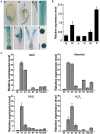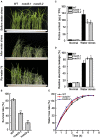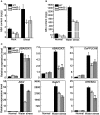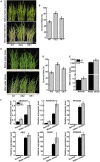9- cis-Epoxycarotenoid Dioxygenase 3 Regulates Plant Growth and Enhances Multi-Abiotic Stress Tolerance in Rice
- PMID: 29559982
- PMCID: PMC5845534
- DOI: 10.3389/fpls.2018.00162
9- cis-Epoxycarotenoid Dioxygenase 3 Regulates Plant Growth and Enhances Multi-Abiotic Stress Tolerance in Rice
Abstract
Although abscisic acid (ABA) is an important hormone that regulates seed dormancy, stomatal closure, plant development, as well as responses to environmental stimuli, the physiological mechanisms of ABA response to multiple stress in rice remain poorly understood. In the ABA biosynthetic pathway, 9-cis-epoxycarotenoid dioxygenase (NCED) is the key rate-limiting enzyme. Here, we report important functions of OsNCED3 in multi-abiotic stress tolerance in rice. The OsNCED3 is constitutively expressed in various tissues under normal condition, Its expression is highly induced by NaCl, PEG, and H2O2 stress, suggesting the roles for OsNCED3 in response to the multi-abiotic stress tolerance in rice. Compared with wild-type plants, nced3 mutants had earlier seed germination, longer post-germination seedling growth, increased sensitivity to water stress and H2O2 stress and increased stomata aperture under water stress and delayed leaf senescence. Further analysis found that nced3 mutants contained lower ABA content compared with wild-type plants, overexpression of OsNCED3 in transgenic plants could enhance water stress tolerance, promote leaf senescence and increase ABA content. We conclude that OsNCED3 mediates seed dormancy, plant growth, abiotic stress tolerance, and leaf senescence by regulating ABA biosynthesis in rice; and may provide a new strategy for improving the quality of crop.
Keywords: CRISPR/Cas9 system; OsNCED3; abiotic stress; abscisic acid (ABA); growth; leaf senescence; seed germination.
Figures










Similar articles
-
Heterologous expression of rice 9-cis-epoxycarotenoid dioxygenase 4 (OsNCED4) in Arabidopsis confers sugar oversensitivity and drought tolerance.Bot Stud. 2018 Jan 15;59(1):2. doi: 10.1186/s40529-018-0219-9. Bot Stud. 2018. PMID: 29335785 Free PMC article.
-
OsNCED5, a 9-cis-epoxycarotenoid dioxygenase gene, regulates salt and water stress tolerance and leaf senescence in rice.Plant Sci. 2019 Oct;287:110188. doi: 10.1016/j.plantsci.2019.110188. Epub 2019 Jul 13. Plant Sci. 2019. PMID: 31481229
-
ABA biosynthesis gene OsNCED3 contributes to preharvest sprouting resistance and grain development in rice.Plant Cell Environ. 2023 Apr;46(4):1384-1401. doi: 10.1111/pce.14480. Epub 2022 Nov 26. Plant Cell Environ. 2023. PMID: 36319615
-
Abscisic acid dynamics, signaling, and functions in plants.J Integr Plant Biol. 2020 Jan;62(1):25-54. doi: 10.1111/jipb.12899. J Integr Plant Biol. 2020. PMID: 31850654 Review.
-
Diverse functional interactions between nitric oxide and abscisic acid in plant development and responses to stress.J Exp Bot. 2014 Mar;65(4):907-21. doi: 10.1093/jxb/ert454. Epub 2013 Dec 26. J Exp Bot. 2014. PMID: 24371253 Review.
Cited by
-
Transcriptome profiling of Arabidopsis slac1-3 mutant reveals compensatory alterations in gene expression underlying defective stomatal closure.Front Plant Sci. 2022 Sep 20;13:987606. doi: 10.3389/fpls.2022.987606. eCollection 2022. Front Plant Sci. 2022. PMID: 36204078 Free PMC article.
-
The Accumulation of Abscisic Acid Increases the Innate Pool of Soluble Phenolics through Polyamine Metabolism in Rice Seedlings under Hexavalent Chromium Stress.Toxics. 2024 Aug 8;12(8):577. doi: 10.3390/toxics12080577. Toxics. 2024. PMID: 39195679 Free PMC article.
-
ABA Metabolism and Homeostasis in Seed Dormancy and Germination.Int J Mol Sci. 2021 May 11;22(10):5069. doi: 10.3390/ijms22105069. Int J Mol Sci. 2021. PMID: 34064729 Free PMC article. Review.
-
Genetic dissection of developmental responses of agro-morphological traits under different doses of nutrient fertilizers using high-density SNP markers.PLoS One. 2019 Jul 23;14(7):e0220066. doi: 10.1371/journal.pone.0220066. eCollection 2019. PLoS One. 2019. PMID: 31335882 Free PMC article.
-
OsWRKY5 Promotes Rice Leaf Senescence via Senescence-Associated NAC and Abscisic Acid Biosynthesis Pathway.Int J Mol Sci. 2019 Sep 9;20(18):4437. doi: 10.3390/ijms20184437. Int J Mol Sci. 2019. PMID: 31505875 Free PMC article.
References
-
- Agrawal G. K., Yamazaki M., Kobayashi M., Hirochika R., Miyao A., Hirochika H. (2001). Screening of the rice viviparous mutants generated by endogenous retrotransposon Tos17 insertion. Tagging of a zeaxanthin epoxidase gene and a novel ostatc gene. Plant Physiol. 125, 1248–1257. 10.1104/pp.125.3.1248 - DOI - PMC - PubMed
-
- Bates L., Waldren R., Teare I. (1973). Rapid determination of free proline for water-stress studies. Plant Soil 39, 205–207. 10.1007/BF00018060 - DOI
LinkOut - more resources
Full Text Sources
Other Literature Sources

